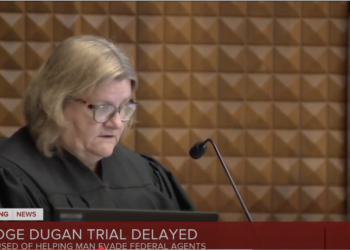The Department of Education can proceed with the mass layoff of around 1,400 employees, the Supreme Court ruled Monday, blocking a rogue lower court order to reinstate the employees.
The order in McMahon v. New York was decided 6-3, and temporarily halted the lower court reinstatement. The three liberal justices offered a 19-page dissent on why the president of the United States, through his cabinet secretaries, should not have the authority to eliminate unnecessary and wasteful positions in the executive branch.
“Today, the Supreme Court again confirmed the obvious: the President of the United States, as the head of the Executive Branch, has the ultimate authority to make decisions about staffing levels, administrative organization, and day-to-day operations of federal agencies,” said Education Secretary Linda McMahon. “While today’s ruling is a significant win for students and families, it is a shame that the highest court in the land had to step in to allow President Trump to advance the reforms Americans elected him to deliver using the authorities granted to him by the U.S. Constitution.”
The order is not a final ruling on the merits of the reduction in force, but it does allow the Trump administration to move forward with what McMahon called the Education Department’s “final mission”: Shutting down and returning education to states, localities, and parents.
In early March, McMahon announced that 1,378 employees across the entire department were subject to the reduction in force or had already been terminated as probationary employees. The department said that many of those employees were redundant or otherwise unnecessary, and not in line with President Donald Trump’s goal of eventually getting rid of the Department of Education — which has been the recipient of much ire from conservatives for years.
Earlier in March, McMahon outlined the Trump administration’s vision for the “final mission” of the department, “The Department of Education’s role in this new era of accountability is to restore the rightful role of state oversight in education and to end the overreach from Washington.”
“This restoration will profoundly impact staff, budgets, and agency operations here at the Department,” she added. “In coming months, we will partner with Congress and other federal agencies to determine the best path forward to fulfill the expectations of the President and the American people. We will eliminate unnecessary bureaucracy so that our colleges, K-12 schools, students, and teachers can innovate and thrive.”
Trump then signed an executive order to set into motion the eventual dismantling of the department, as far as the executive branch is able to act without congressional approval. Completely dissolving the department will require action from Congress.
Justice Sonia Sotomayor wrote a dissent in Monday’s order, arguing that the Trump administration is attempting to unilaterally shut down the department without Congress, which the White House had persistently maintained it cannot do.
Concerned with funneling federal tax dollars to states and localities, Sotomayor failed to mention that the department will maintain and fully execute its congressionally mandated programs. Perhaps more plainly, however, Sotomayor’s dissent attempts to change the argument from whether or not the chief executive has the authority over staffing decisions to execute congressional mandates, to whether the Trump administration is trying to illegally shutter the department without Congress — a power not fundamentally at issue in the case.
“When the Executive publicly announces its intent to break the law, and then executes on that promise, it is the Judiciary’s duty to check that lawlessness, not expedite it,” she wrote, apparently forgetting that a reduction in force is a legal process created by Congress, which is being followed by the department in its terminations.
“It hands the Executive the power to repeal statutes by firing all those necessary to carry them out,” Sotomayor continued, without citing evidence of any statute at risk of not being executed.
Undeterred by these limits on executive authority, President Trump has made clear that he intends to close the Department without Congress’s involvement. During his campaign, Trump repeatedly asserted that he planned to “‘clos[e] up the Department of Education’” and “‘sen[d] all education and education work . . . back to the states’” “‘early in the administration.’” Following the election, Trump continued that refrain: “[Y]ou can do a lot of things without Congress,” he told the press, including a “virtual closure of [the] Department of Education.” After taking office, President Trump described the Department as a “‘big con job’” and reiterated that he would “‘like to close it immediately.’”
Not even Trump’s own executive order displays intent to bypass Congress. When referencing closing the department, the order says to do so “to the maximum extent appropriate and permitted by law” — “law” being those things that Congress passes, for Sotomayor’s information.
The order mentions again that “this order shall be implemented consistent with applicable law.” McMahon has maintained that actually shutting down the department would require congressional approval and testified to the Senate that “it is not the president’s goal to defund the programs, it is only to have it operate more efficiently.”
Sotomayor apparently does not understand that touting political ideals, like shuttering the department (a campaign promise upon which Trump as elected), are not actually taking the action to do so. They describe the will of the people.
And yet, after a lengthy diatribe about how Trump is trying to singlehandedly shut it down, despite all evidence to the contrary, Sotomayor on the tenth page of her dissent finally admits, “Nor did it [the federal government] argue that the Executive could singlehandedly abolish the Department.”
Breccan F. Thies is a correspondent for The Federalist. He previously covered education and culture issues for the Washington Examiner and Breitbart News. He holds a degree from the University of Virginia and is a 2022 Claremont Institute Publius Fellow. You can follow him on X: @BreccanFThies.















